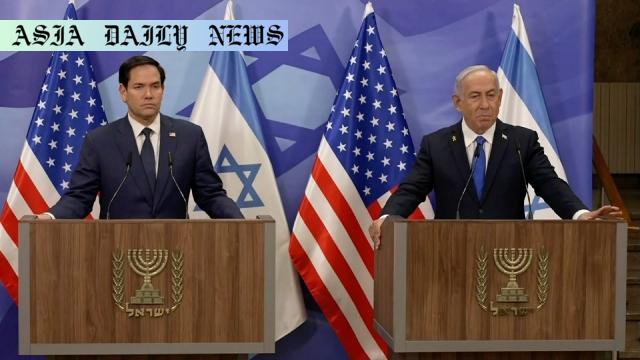Gaza Strip: Netanyahu and Rubio discussed President Trump’s bold vision for Gaza’s future and ways to make it a reality.
Israeli PM Netanyahu met with US Secretary of State Marco Rubio in Jerusalem to discuss Trump’s Gaza vision.
They explored ways to turn Trump’s bold proposal for Gaza into a reality, focusing on sustainable solutions.
The discussion touched upon Trump’s call to reconstruct Gaza and relocate its residents as part of a transformative plan.
Hamas’ recent hostage releases and Israel’s prisoner exchange provide some progress but remain peripheral to larger negotiations.

Introduction: A Vision for Gaza
In a significant development, Israeli Prime Minister Benjamin Netanyahu confirmed his meeting with US Secretary of State Marco Rubio in Jerusalem. The primary agenda of their discussion was US President Donald Trump’s ambitious and controversial proposal concerning the Gaza Strip. The discussions transcended routine diplomacy, focusing on realizing a ‘bold vision’ for this troubled region, which, if implemented, could lead to transformative changes.
The Trump Proposal: Reconstruction and Relocation
President Trump’s proposal for the Gaza Strip suggests a sweeping change: reconstruction of the territory and relocation of its residents. These ideas, bold as they are, echo a determination to break free from the cyclical violence and instability that have characterized Gaza for decades. However, such ideas have sparked debate and controversy on the global stage. Would reconstructing Gaza, paired with relocating its residents, bring peace? Or does it raise more questions than answers?
Netanyahu and Rubio’s Discussion
Prime Minister Netanyahu described his meeting with Rubio as highly productive. Their priority was to strategize actionable ways to turn Trump’s bold vision into reality. While they were optimistic, they were also pragmatic in acknowledging the on-ground challenges. Netanyahu emphasized that the discussions were crucial, given the delicate nature of the ongoing ceasefire between Israel and Hamas.
Ceasefire Progress and Challenges
The six-week ceasefire agreement that started on January 19 has brought temporary relief to the region. Under this agreement, Hamas has released 19 hostages out of the 33 promised, while Israel has freed over 1,100 Palestinian prisoners. Yet, the road to a complete resolution remains fraught with obstacles. The second phase of the ceasefire agreement, which aims to end hostilities permanently and ensure the release of all hostages, has seen little success in negotiations.
Global Implications of Trump’s Vision
The proposal to reconstruct Gaza and relocate its residents is unprecedented, setting it apart from traditional diplomatic approaches. If successful, this could serve as a blueprint for resolving similar conflicts globally. However, it also raises ethical and logistical questions. Where would the residents of Gaza be relocated? Would countries in the region or beyond cooperate in such an endeavor? These unanswered questions underscore the complexity of the issue.
Way Forward: Beyond Hostage Negotiations
Netanyahu and Rubio’s discussions highlighted the need for a comprehensive approach to ensure sustainable peace. While negotiations concerning hostages are critical, they are but one piece of the puzzle. A long-term solution would require greater international collaboration, addressing humanitarian challenges, and fostering dialogue among conflicting parties.
Conclusion: Hope Amidst Challenges
As the dialogue between Netanyahu, Rubio, and other stakeholders continues, there is cautious optimism. President Trump’s bold vision, while controversial, has rekindled discussions on the future of the Gaza Strip. Turning this vision into reality will require unprecedented coordination and goodwill from multiple stakeholders. For now, the discussions in Jerusalem remain a significant step towards addressing one of the region’s most enduring conflicts.
Commentary
The Complexity of Gaza’s Future
The recent discussions between Israeli Prime Minister Benjamin Netanyahu and US Secretary of State Marco Rubio touch upon a critical yet highly contentious issue: the future of the Gaza Strip. President Trump’s vision, ambitious and polarizing, marks an attempt to disrupt the decades-long cycles of violence and instability in the region. However, it is not without its challenges or critics. Discussions like the one held in Jerusalem signal an openness toward not only envisioning solutions but also actively seeking ways to realize them.
Breaking Out of the Cycle
One of the key takeaways from Rubio’s comments is the recognition that the current trajectory in Gaza is unsustainable. For too long, the region has been stuck in a cycle where temporary agreements lead to brief respites, only to return to conflict and devastation. Trump’s proposal may provide an opportunity to change this narrative, but its implementation is fraught with uncertainties. The idea of relocating Gaza’s residents, for instance, opens up a host of humanitarian and geopolitical questions that will need careful deliberation.
A Call for International Collaboration
For any vision of peace in Gaza to succeed, it will demand the active participation of the international community. From rebuilding infrastructure to addressing the needs of displaced individuals, the scale of work required extends far beyond Israel and the United States. The broader Middle East, along with global institutions, will need to step up to ensure this vision translates into a reality that benefits all parties involved.
Optimism Tempered with Pragmatism
While optimism abounds regarding the potential for change, it is crucial to temper it with pragmatism. The complex web of political, social, and economic factors at play in Gaza makes any progress hard-earned. Yet, the willingness of leaders like Netanyahu and Rubio to engage in meaningful dialogue, coupled with bold ideas from figures like Trump, provides a foundation upon which further efforts can be built. Gaza’s future remains uncertain, but hope persists amidst the challenges.


